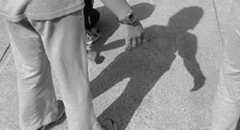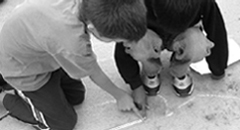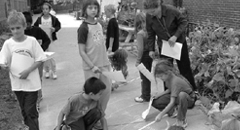
|

|

|
Consider the following components when creating documentation for exhibition or display.
Title A good title helps give the viewer an immediate sense for your piece. Try for something that gets at the meaning of the documentation. You might want to use a child's or adult's quote or imaginative way of expressing something or a metaphor—anything that will pique viewer interest and convey what the learning is about. The title should be prominently placed and large enough to draw the viewer's attention to it.
Context Try to keep the context to no more than two to three short paragraphs of background information that will help set the stage for viewers. The context should include the teacher/documenter name(s), the age group of the learners, the names of the school and town, the purpose of the learning experience, and the date or time period. Photos or images of the learners are helpful to provide up front. Other information to include as relevant is the learning prompt or project, the size of the group, related previous experiences, or materials used. Photographs or other visual documentation can also provide some of this information.
Supporting Artifacts Carefully select from the various artifacts or documents you are collecting (transcripts, photographs, student work, etc.) the things most critical for helping viewers see how you came to your interpretations about learning (see below) or allow for other interpretations. The artifacts should represent the learning process as well as product—the how as well as the what of learning. Ideally, there would be two media such as text (narrative and/or quotes) and images in what you select.
Your Analysis or Interpretation Include your own learning in the documentation. What was exciting or surprising to you about the experience of the learners? What moved you or furthered your thinking? Can you make connections to broader issues or images of teaching and learning? You might want to include brief reflections at the beginning and end, and occasional commentary throughout the piece to communicate the meaning you are making of the documentation. Think about the story of learning you want to tell and the conversations about learning you'd like to open up. If applicable, you might also want to note how the documentation will help you shape future learning experiences.
Format Consider coming up with a uniform format for your documentation so that viewers won't have to figure out how to "read" it every time you post something new. In a school setting, you might decide on criteria such as using technology that is accessible to everyone and easy to use. Generally try to format your documentation on a computer or by hand on small, standard-sized paper (8.5" x 11 or 14") rather than big posters. This allows it to be easily copied and distributed to colleagues for feedback, or brought back to the classroom and added to over the course of a project. If you choose to put up panels, their size will depend on the setting, but dimensions of 4' by 3' are often manageable. Try to present things in a way that allows the viewer to take in the key information in roughly five-ten minutes. For those viewers who want to explore the work more deeply, you can provide additional information or artifacts that sit or hang near the main piece.
Things to Watch Out For Beware of including too much written text?Try to balance learning about learning and learning content?It is sometimes more powerful to document the experience of one small group or one moment or event in the learning experience rather than an entire lesson or unit?Asking yourself, "What is the learning I want to make visible?" can help guide you if you are feeling adrift in a sea of data?
© 2006 Making Learning Visible Project at the Harvard Graduate School of Education
[Home] [Site Map]